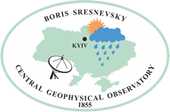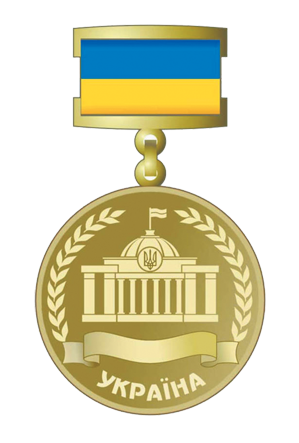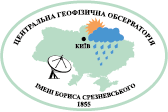The history of the CSO
History of the CSO
The first period
On May 23, 1844, the St. Petersburg Imperial Academy of Sciences sent a letter to the trustee of the Kyiv educational district with a proposal: "...to establish meteorological observatories at gymnasiums and schools where it is considered preferable and to open institutions of the same kind in Kyiv itself, from which station managers could receive the instructions and information they need at the same time..."
On August 24, 1846, the trustee of the Kyiv Educational District approved the proposal of Professor of Physical and Mathematical Sciences Venedikt Chekhovych "On the organization of a network of meteorological stations and a central institution of this kind in Kyiv itself." In his opinion: " St. Volodymyr's University of Kyiv has everything it needs to set up a Meteorological Observatory."
V. Chekhovych asked the Academy of Sciences to provide the observatory and the network of meteorological stations with instruments, but due to lack of funds, the Academy of Sciences proposed to limit the arrangement of the Meteorological Observatory in Kyiv at the university.
On July 8, 1848, the University Council decided to locate a separate temporary wooden building in the Botanical Garden, and on February 12, 1851, the director of the Main Physical Observatory, Professor Adolf Kupfer, approved the project of the stone building of the Meteorological Observatory in Kyiv, prepared by the architect Beretti.
Construction of the building began on May 18, 1851, at 14 Pavlo Skoropadskoho Street. The official opening took place on May 15, 1855, which makes May a lucky month for the observatory.
This building, located at 14 L. Tolstoy Street, had a plaque of an architectural monument, but it was rebuilt and a "very important" object for the capital appeared in its place - the Mario Casino.
The first director of the observatory from 1855 to 1858 was Ernest Knorr, a professor of physics at Kyiv University.
Meteorological observations at the Kyiv Observatory were the main ones. Already in May 1855, the "Scientific Notes" (later "UniversityNews"?) of Kyiv University published weather observations made from May 15 to 20 of that year.
The heads of the observatory in the nineteenth century were usually prominent scientists. Matvii Talyshyn, a professor of physics and mathematics at Kyiv University, was the director of the observatory from 1858 to 1865. During this period, he organized the monthly publication of meteorological observations in theUniversity News.
From 1865 to 1885, the observatory was headed by Mikhail Avenarius, one of the most prominent physicists of the second half of the nineteenth century. He is the author of one of the first works on meteorology, "Some of the results of 12 years of observations of the University Meteorological Observatory," published in theUniversity News in 1868.
Mykhailo Petrovych achieved material incentives for observers, strengthened the material base of the observatory, expanded the scope of meteorological observations, and created a school of meteorologists.
Alexander Klossovsky was a student and follower of M.P. Avenarius. During the 90s of the nineteenth century, he organized and directed the activities of the meteorological network of Southwestern Russia. This network covered the Bessarabian, Kherson, and Tavriya provinces, as well as the southern districts of Kyiv and Podillia. All the meteorological stations he organized kept records of temperature, atmospheric phenomena, snow cover, precipitation, and a detailed or abbreviated agricultural diary. The main focus was on the agricultural component of meteorological observations.
The network was maintained at the expense of provinces, cities, and government agencies. Observations were published in the works of the meteorological network of Southwestern Russia. A total of 6 volumes of this publication were published.
The authority of the observatory grew during the period of Petro Brownov's leadership in 1891-1895. He began his work by expanding the observation program at the network of subordinate meteorological stations. Soon he organized the regular publication of the Observations of the Meteorological Observatory (more than 40 issues in total) and the publication of the Works on Agricultural Meteorology.
Petro Brownov organized the Prydniprovia network of meteorological stations, which included meteorological stations in Kyiv, Chernihiv, Poltava, Kharkiv, Kursk, Orel, Mogilev, Minsk, and Hrodna provinces.) In total, the network in 1896 included more than 700 weather stations, which is much more than today. The Prydniprovia Meteorological Network, organized by Brownov, operated until the beginning of 1918.
Many years of work in the field of agricultural meteorology brought Petro Brown world fame and he rightfully belongs to the founders of agrometeorology, the foundations of which were laid in Kyiv.
For twenty years, from 1895 to 1916, the Observatory was headed by Iosyp Kosonohov. Under his leadership, the observatory developed new specialized types of observations of rainfall, solar radiation, etc. He organized a service of information about the vegetation and harvest of crops, and published 52 issues of the Agricultural Meteorological Bulletin of the Kyiv Meteorological Observatory.
In April 1918, at the request of the then director of the Kyiv Meteorological Observatory, Czesław Białobrzewski, the University Council authorized the launch of "pilot balloons." And on April 15, the first pilot was launched from the anemometric tower over the western part of the university building.
During World War I, the hydrometeorological network was reoriented to meet the needs of the army.
According to the veterans of the observatory, during the Ukrainian People's Republic, the chief ataman of the Ukrainian People's Republic, Symon Petliura, got acquainted with the work of the observatory. Unfortunately, in the following years the team was not honored to be visited even by the minister.
In 1924, the Magnetic and Meteorological Observatory was withdrawn from the Kyiv Institute of Public Education and subordinated to the Ukrainian Academy of Sciences. In 1926, the Department of Geophysics and Agricultural Meteorology was organized at Ukrnautica, headed by Borys Sreznevsky, who remained the director of the observatory at the same time.
In 1929, the Observatory became part of the newly created Hydrometeorological Committee of the Ukrainian SSR.
The city's conditions made it difficult to conduct meteorological observations. Therefore, at the initiative of Ukrmet's CEO Mykola Danylevsky, it was decided in 1925 to organize a geophysical observatory in the countryside. To this end, a site was chosen near the village of Tymky 3a, 20 km south of Bobrovytsia, Chernihiv Oblast. In January 1926, meteorological observations began at the observatory in Tymky. The main area of work was aerology. However, the location of the forest near the observatory hindered observations. The observatory was soon moved to Boryspil.
Regular meteorological observations in Boryspil began in July 1931. In 1934, magneto-meteorological and actinometric observations were moved here from Kyiv.
The Boryspil Geophysical Observatory had the most modern equipment and instruments of the time, qualified employees, and was the largest meteorological and geophysical institution in Ukraine.
The 75th anniversary of the Observatory was dedicated to an article by its then-head, Ivan Polovko, in the fifth issue of the Weather and Life magazine in 1930.
In 1935, the observatory began launching radiosondes. In the same year, a radiosonde was launched in Kyiv from Bohdan Khmelnytsky Square. The launch was witnessed by Mykhailo Halchenko, who later served as the director of the Ukrainian Hydrometeorological Observatory in 1976-1981.
The first director of the Boryspil Observatory was Tymofii Bohatyr, the future head of the Ukrainian Hydrometeorological Service for many years. Later, the observatory was headed by Nikolai Helmholtz, Naum Pinus, Vasyl Lichikaki, and from 1940 until the beginning of the war, Oleksandr Fedoseiev.
After the return of Soviet power to Kyiv, the work of the Geophysical Research Observatory resumed. At that time, its leaders were: Valentyn Popov (1944 - 1948), Hennadii Prykhotko (1948 - 1950), Pavlo Andriichenko (1950 - 1952), and Ilya Daniltsev (1952 - 1953).
The observatory introduced new methods of observation. For example, in 1947, observations of atmospheric electricity began.
Agrometeorological observations and research of the Geophysical Observatory were continued at the Kyiv Agrometeorological Station, which was opened on the outskirts of the city at that time. Nowadays, the United Hydrometeorological Station Kyiv is located here (37 Prospekt Nauky), where meteorological data are daily exchanged internationally and where the Observatory was awarded a Certificate of Merit by the World Meteorological Organization in 2005 for the high quality of its observations.
In 1953, the Ukrainian Research Hydrometeorological Institute was established on the basis of the Geophysical and Hydrological Observatories in Kyiv. It included the research departments, sectors and laboratories of these observatories. The establishment of the Ukrainian Hydrometeorological Research Institute marked the end of the first period of the Observatory's activity.
The second period
In 1956, a new stage in the observatory's activities began when the Kyiv Meteorological Observatory was organized on the basis of the regime departments of the Ukrainian Hydrometeorological Service. Its first director was Ivan Lapa (1956-1961), who was later replaced by Oleksandr Moroz (1961-1965). After him, the Observatory was headed by Oleksandr Prykhodko (1965 - 1971), Valentyn Shmakov (1971 - 1976), and Mykhailo Halchenko (1976 - 1981).
From 1956 to 1959, the Kyiv Hydrometeorological Observatory was located in the premises of the Hydrometeorological Service Administration (6 Zolotovoritska St.); from 1959 to 1964, it was located at 14 Tolstoho St., and since 1964, it has been at its current address: 39 Nauky Avenue, building 2.
The restored observatory includes departments, laboratories and groups of meteorology and climate, actinometry, aerology, hydrology, hydrographic party, laboratory of surface water and atmospheric chemistry, hydrometeorological data fund, etc. This time is characterized by the rapid development of observations of chemical pollution and radiation pollution.
A significant year in the history of the observatory was 1973. In that year, the state service for monitoring and controlling environmental pollution was basically established on the territory of Ukraine. Due to the increase in the volume of work and taking into account the large proportion of new types of observations, on May 15, 1973, the Kyiv GMO was reorganized into the Ukrainian Hydrometeorological Observatory.
The network reached its greatest development in the early 90s. Starting in 1992-93, its development slowed down, which did not prevent the network and the quality of observations of environmental pollution from being preserved.
The second period was coming to an end under the leadership of Mykola Padun, who was the director of the observatory in 1981-83. According to the order of the former USSR State Committee for Hydrometeorology, republican hydrometeorological centers were established on the basis of republican observatories and weather bureaus, including the one in Kyiv, now known as the Ukrainian Hydrometeorological Center.
In 1983, the observatory was transformed into the Kyiv Center for Observation and Control of Environmental Pollution, which was renamed the Ukrainian Center for Radiation Control of Environmental Pollution on July 1, 1986, and was headed by Oleh Serebriakov on August 1, 1986. On November 1, 1988, the Center was headed by Oleksandr Kosovets. Gradually, the center included all the hydrometeorological stations of Kyiv region and Kyiv. In May 1996, the center was returned to the status and name of the observatory - the Central Geophysical Observatory. Thus, the second period of the observatory's life ended and its third period began.
The third period
The last almost three decades have been marked by a gradual strengthening of the Observatory's authority and greater independence in solving financial and economic issues. In particular, in the first quarter of 1989, the Observatory switched to an independent financial balance sheet and for the first time in its history acquired the status of a full-fledged organization.
In 1995, by a Governmental Decree, the Branch State Archive of the Ukrainian Hydrometeorological Service was established as part of the Republican Center for Observations of the State of the Environment (as the CSO was called at that time), which was the successor of the Hydrometeorological Fund (Hydrometfond), founded at the Kyiv Meteorological Observatory in 1958.
In May 1996, the observatory received its modern name, which allowed it to build a bridge from the mid-nineteenth century to the end of the twentieth. Moreover, the name "Central Geophysical Observatory" was included in the Law on Hydrometeorological Activities, which was adopted by the Verkhovna Rada of Ukraine in February 1999.
The materials of the CGO form the basis of many scientific works, including the monograph "Hydrometeorological Characteristics of Ukrainian Rivers" by Viktor Vyshnevsky and Oleksandr Kosovets, as well as the "Ecological Atlas of Kyiv".
Since 2005, on the initiative of the head of the Institute, the annual publication of the "Proceedings of the Central Geophysical Observatory" has been resumed, and since 2018, under the new title "Proceedings of the Borys Sreznevsky Central Geophysical Observatory", which were first published in 1948.
In February 2006, on the occasion of the 150th anniversary of its foundation, the Central Geophysical Observatory was awarded a diploma of the Verkhovna Rada of Ukraine for its services to the Ukrainian people.
Since September 2010, the first channel of Ukrainian radio began its morning broadcast with information about daily minimum and maximum temperatures in Kyiv based on observations of the observatory since 1881.
In 2011, the meteorology department of the CCA prepared a climatological reference book "History and physical and geographical description of meteorological stations in Ukraine".
In 2016, with the assistance of Oleksandr Kosovets, permission was obtained to launch an experimental probe, which included a GPS (Global Positioning System) navigator, at the United Hydrometeorological Station (UHMS) in Kyiv.
A landmark event took place in the life of the observatory in 2017, when the Ministry of Internal Affairs of Ukraine named the Centralized Hydrometeorological Observatory after the famous scientist, physicist, and meteorologist Borys Sreznevsky.
In 2021, Andriy Kutsyi became the director, gradually modernizing the work of the CSO. The staff is gradually rejuvenated, the technical base is being updated, the workflow is being digitalized, and media and outreach activities are being expanded.
Since Russia's full-scale invasion of Ukrainian lands on February 24, 2022, even when observations at meteorological stations and hydrological posts posed a mortal threat, the Hydrometeorological Service employees continued to work, transmitting the data to the Civil Defense Center.
In the same year, the book "Multiple Changes in the Water Regime of Ukrainian Rivers" was published, prepared by Professor Viktor Vyshnevsky and Andriy Kutsym, Director of the Centralized Hydrometeorological Organization. The content of the book is largely based on long-term observation data covering the period from 1851 to 2020 inclusive.
On June 24 of the same year, the work of the CSO was officially registered as a popular science publication.
In 2022, painstaking work was completed on the creation of the Ukrainian Climate Inventory, which is the largest and most reliable source of climate data in the country and has data for 1991-2020.
Based on the analysis of the Cadastre data, Professor Viktor Vyshnevsky, Head of the Climate Science Department of the CGO Olena Donich and Andriy Kutsym, Director of the CGO, prepared the book "Climate of Kyiv and its environs", which was presented on World Water Day and on the eve of World Meteorological Day on March 22, 2023.
Today, the Observatory is the oldest organization in the Ukrainian
In the summer of 2024, cooperation began with the Finnish Meteorological Institute (FMI) within the framework of the Finnish-Ukrainian project FMI-UHMC. As part of this project, the first automatic weather station was installed at one of the stations under the Central Geophysical Observatory (Kyiv Hydrometeorological Station) in December of the same year, followed by a second station at the Myronivka Agrometeorological Station.
On the eve of Rescuer's Day, which is celebrated on September 17, 2024, a new book titled "Emergencies in Ukraine" was published. The uniqueness of this book lies in the fact that no similar publication had ever been released before. Meanwhile, the number of emergencies that have occurred in Ukraine is countless. Some of them — including the Holodomor, the world wars, the Chornobyl disaster, and the ongoing Russian-Ukrainian war — have affected millions, even tens of millions of people. Sadly, millions of lives have been lost in these emergencies.
The new book, presented on October 8 of the same year, serves not only as a reminder of these tragic events but also as a collection of numerous facts and recommendations aimed at making our lives safer.
Today, the Observatory is the oldest organization in the Ukrainian Hydrometeorological Service, and its breadth of activities is unparalleled in Europe.
Over the years of its development, the Borys Sreznevsky Central Geophysical Observatory has acquired a complex structure that includes a number of stations (Myronivka Agrometeorological Station, Kyiv Hydrological Station, combined Vyshhorod and Kyiv Hydrometeorological Stations, as well as Baryshivka, Boryspil, Teteriv Yahotyn, Bila Tserkva, Fastiv and Chornobyl weather stations), departments and sectors that are closely interconnected. The work directly covers meteorological, climatological, hydrological measurements, obtaining data for radiation and environmental control, monitoring of chemical pollution and information on the state of environmental pollution. Regular measurements that do not stop even now. They are used in the agricultural sector, construction, design and forecasting, and starting from February 24, 2022, they are actively used by the Armed Forces of Ukraine, which is an opportunity to prove the usefulness of the Centralized Civil Defense Center in the military field.







